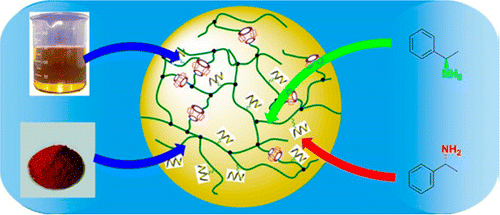
This article reports optically active microspheres consisting of chiral helical substituted polyacetylene and β-cyclodextrin-derivative (β-CD-A). The microspheres showed remarkable adsorption toward various organic compounds in water. To prepare the microspheres, an acetylenic-derived helical macro-monomer was synthesized and then underwent aqueous suspension copolymerization with octadecyl acrylate and butyl acrylate by using azobis- (isobutyronitrile) as initiator and β-CD-A simultaneously as comonomer and cross-linking agent. The helical macromonomer chains enabled the microspheres to exhibit desirable enantio-differentiating adsorption capacity toward chiral compounds respectively dissolved in organic solvent, dispersed in water, and dissolved in water. The saturated absorbency toward (R)-(+)-and (S)-(−)-1-phenylethylamine was 29 and 12 mg·g−1, respectively. The microspheres also showed large oil absorbency (e.g., 22 g·g−1 CCl4) and a large adsorption toward methyl red (as a model for organic dyes) dispersed in water. The presence of β-CD-A moieties improved the adsorption performance of the microspheres. The present optically active microspheres open a new approach for preparing adsorbents particularly chiral adsorbents with potentials for wastewater treatment.
